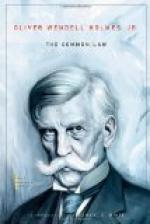167/1 XXXI. 16.
168/1 “Peterit enim rem suam petere [civiliter] ut adiratam per testimonium proborum hominum, et sic consequi rem suam quamvia furatam. . . Et non refert utrum res que ita subtracta fuit extiterit illius appellantis propria vel alterius, dum tamen de custodia sua.” Bract., fol. 150 b, 151; Britton (Nich. ed.), I. 59, 60 [23 b], De Larcyns; cf. ib. 67 [26 b]; Fleta, fol. 5i, L. I. c. 38, Section 1.
169/1 Y.B. 21 & 22 Ed. I. 466-468, noticed in North Amer. Rev., CXVIII. 421, n. (So Britton [26 b], “Si il puse averreer la perte.”) This is not trover. The declaration in detinue per inventionem was called “un newfound Haliday” in Y.B. 33 Hen. VI. 26, 27; cf. 7 Hen. VI. 22, pl. 3; Isack v. Clarke, I Rolle, R. 126, 128.
169/2 Y.B. 2 Ed. IV. 4, 5, pl. 9; 21 Hen. VII. 39, pl. 49; Bro. Trespass, pl. 216, 295.
169/3 2 Wms. Saund. 47, n. 1. See above, p. 167.
170/1 Notes to Saunders, Wilbraham v. Snow, note (h).
170/2 Y.B. 11 Hen. IV. 23, 24. See, further, Y.B. 8 Ed. IV. 6, pl. 5; 9 Ed. IV. 34, pl. 9; 3 Hen. VII. 4, pl. 16; 20 Hen. VII. 1, pl. 1; 21 Hen. VII. 14 b, pl. 23; 13 Co. Rep. 69; 1 Roll. Abr. 4(I), pl. I; F. N. B. 86, n. a; supra, p. 167.
170/3 Fitz. Abr. Barre, pl. 130; Y.B. 9 Ed. IV. 34, pl. 9; 12 Am. Law Rev. 694.
171/1 2 Steph. Comm. (6th ed.), 83, cited Dicey, Parties, 353; 2 Bl. Comm. 453; 2 Kent, 585. As the bailee recovered the whole value of the goods, the old reason, that he was answerable over, has in some cases become a new rule, (seemingly based on a misunderstanding,) that the bailee is a trustee for the bailor as to the excess over his own damage. Cf. Lyle v. Barker, 5 Binn. 457, 460; 7 Cowen, 68l, n.; White v. Webb, 15 Conn. 302, 305; in the order cited. (Thence the new rule has been extended to insurance recovered by a bailee. 1 Hall, N. Y. 84, 91; 3 Kent’s Comm. (12th ed.), 371, 376, n. 1 (a).) In this form it ceases to be a reason for allowing the action.
171/2 Y.B. 48 Ed. III. 20, pl. 8; Bro. Trespass, pl. 67. Cf. 1 Britton (Nich. ed.), 67 [26 b]; Y.B. 6 Hen. VI1. 12, pl. 9; 12 Ed. IV. 13, pl. 9; 12 Am. Law Rev. 694.
172/1 Y.B. 22 Ed. IV. 5, pl. 16.
172/2 2 Rolle, Abr. 569, Trespass, 5. Cf. Y.B. 20 Hen. VII. 5, pl. 15; 21 Hen. VII. 39, pl. 49; Clayton, 135, pl. 243; 2 Wms. Saund. 47 e (3d ed.).




